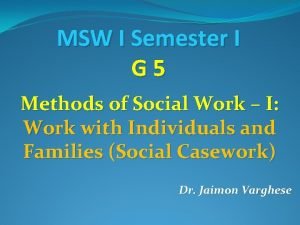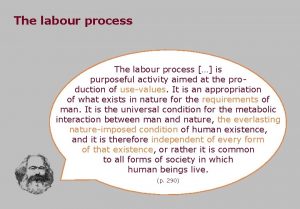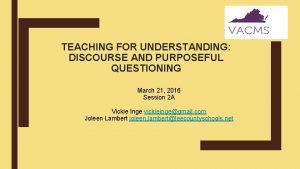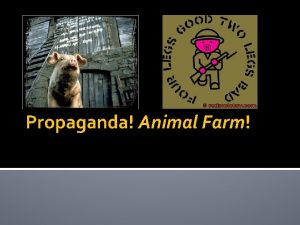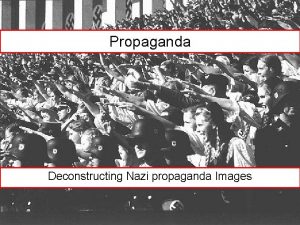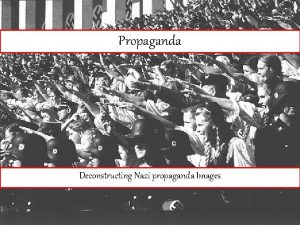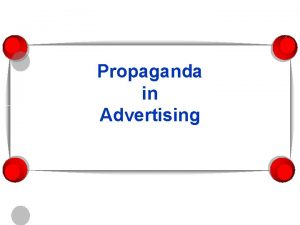Propaganda Propaganda is a systematic form of purposeful












- Slides: 12

Propaganda �Propaganda is a systematic form of purposeful persuasion that attempts to influence the emotions, attitudes, opinions, and actions of specified target audiences for ideological, political, or commercial purposes. � Propaganda is achieved through the controlled transmission of one-sided messages (which may or may not be factual) via mass and direct media channels. �The term's connotations are mostly negative.

Propaganda Techniques � VOTE � Testimonial: Someone endorses a product, patent, or program, often a celebrity. � Appeal to Authority: Appeals to authority cite prominent figures to support a position, idea, argument, or course of action. � Ad Nauseum: This argument approach uses tireless repetition of an idea. An idea, especially a simple slogan, that is repeated enough times, may begin to be taken as the truth. This approach works best when media sources are limited and controlled by the propagator. “The Man of Steel dreams of a Man Who's Real. ”

Propaganda Techniques Bandwagon: and "inevitablevictory" appeals attempt to persuade the target audience to join in and take the course of action that "everyone else is taking. “ • AT&T 4 G Commercial •

Propaganda Techniques �Name Calling: links a person, or idea, to a negative symbol. Examples: commie, fascist, witch. �Ad Hominem: A Latin phrase which has come to mean attacking your opponent, as to attacking their arguments. Ad Hominem Attack

Propaganda Techniques �Black and White Fallacy: Presenting only two choices, with the product or idea being propagated as the better choice. (e. g. , "You are either with us, or you are with the enemy")

Propaganda Techniques �Common Man: The "'plain folks'" or "common man" approach attempts to convince the audience that the propagandist's positions reflect the common sense of the people. It is designed to win the confidence of the audience by communicating in the common manner and style of the target audience. �Propagandists use ordinary language and mannerisms in attempting to identify their point of view with that of the average person. �Mitt Romney Ad

Propaganda Techniques �Direct Order: This technique hopes to simplify the decision making process by using images and words to tell the audience exactly what actions to take, eliminating any other possible choices.

Propaganda Techniques �Glittering Generalities: These are emotionally appealing words applied to a product or idea, but which present no concrete argument or analysis. Mc. Donald’s Commercial

Propaganda Techniques Appeal to Fear: (also called argumentum ad metum or argumentum in terrorem) is a fallacy in which a person attempts to create support for an idea by using deception and propaganda in attempts to increase fear and prejudice toward a competitor. The appeal to fear is common in marketing and politics.

Propaganda Techniques • Card-Stacking: Manipulating information to make a product appear better than it is often by unfair comparison or omitting facts. • i. Pad vs. Windows

Propaganda Techniques �Half Truth: A deceptive statement which may come in several forms and includes some element of truth. The statement might be partly true or totally true, but only part of the whole truth.

Propaganda Techniques �Transfer: Also known as Association, this is a technique of projecting positive or negative qualities (praise or blame) of a person, entity, object, value, group, organization, nation, to another. �It evokes an emotional response. �Often highly visual, this technique often utilizes symbols superimposed over other visual images.
 Purposeful leadership
Purposeful leadership What is traditional action
What is traditional action Seven principles of social work
Seven principles of social work Purposeful leadership
Purposeful leadership Purposeful expression of feelings in social work
Purposeful expression of feelings in social work Nurse leader rounding tools
Nurse leader rounding tools Discriminative listening
Discriminative listening Direct and purposeful experiences
Direct and purposeful experiences Purposeful action examples
Purposeful action examples Labour is the purposeful process of
Labour is the purposeful process of Pose purposeful questions
Pose purposeful questions Listening activity
Listening activity The best business writing is purposeful, economical, and
The best business writing is purposeful, economical, and




